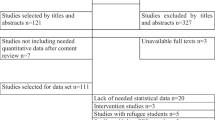Abstract
The paper addresses language and translation problems in the most typical measures of happiness and overall life satisfaction in international surveys using an experimental design. In the experiment, randomly selected groups of Danish university students answered questionnaires in English and Danish, respectively. We found significant differences in the answers on both indices. As such, it was confirmed that the term “happy” is not the same in English and Danish. In Danish the word is similar to the German word “glücklich” which seems to refer to something stronger than just being “happy”. Perhaps more surprisingly, we also found a significant difference between the answers on “overall life satisfaction”, indicating that the answers given in Danish are too high as compared to the English ones. The differences are large enough to argue that such simple tests should be conducted before ranking countries in terms of these two well-established indices of subjective well-being.

Similar content being viewed by others
Notes
There are small variations over time, perhaps explainable by the relative economic performance. Among rich countries economic growth does not have much impact on well-being, but better or worse economic performance than in the neighbouring country does seem to affect aggregate subjective well-being.
Another variation is to include questions about specific life areas such as working life, family life, financial situation, etc.
See e.g. Standard Eurobarometer 65, 2006: http://ec.europa.eu/public_opinion/archives/eb/eb65/eb65_en.htm.
European Values Study 1990: http://www.europeanvaluesstudy.eu/evs/surveys/survey-1990.html.
Such cultural differences may also be found between different classes, regions, or subcultures within a country.
Gilbert (2006: 37–38) discuss two different meanings of happiness—an “emotional” and a “judgemental” understanding, respectively. The latter is exemplified by the sentence: “I’m happy they caught the little bastard who broke my windshield”. This does not imply any deep feeling of pleasure.
Own analyzes.
In order to minimize random variation, however, the two groups (and subgroups, see below) were stratified on gender and type of education.
This tendency is supported by a subsequent survey experiment where we tested two different, Danish wordings of these answering ankers to the ESS question on happiness: one with a direct translation from the English term “Extreme” and another with the actual ESS translation, which is notorious less demanding. Also in this experiment we find a highly statistical bigger proportion answering in the highest category in the question with the less demanding translation of “extreme happy”.
References
Braun, M., & Harkness, J. A. (2005). Text and context: Challenges to comparability in survey questions. In J. H. P. Hoffmeyer-Zlotnik & J. A. Harkness (Eds.), Methodological aspects in cross-national research, Nachrichten, GESIS ZUMA, Spezial Band 11.
Diener, E. (2009). Subjective well-being. In E. Diener (Ed.), The science of well-being: The collected works of Ed Diener. Social indicators research series (pp. 11–57). Berlin: Springer.
Duncan, G. (2005). What do we mean by ‘Happiness’? The relevance of subjective wellbeing to social policy. Social Policy Journal of New Zealand, 25, 16–31.
Gilbert, D. (2006). Stumbling on happiness. New York: Harper Perennial.
Harkness, J. A., & Alicia S. (1998). Questionnaires in translation. ZUMA-Nachrichten Spezial.
Hellevik, O. (2008). Jakten på den norske lykken. Oslo: Universitetsforlaget.
Helliwell, J. F., Layard, R., & Sachs, J. (Eds.). (2013). World happiness report 2013. New York: Eath Institute.
Hopkins, D. J., & King, G. (2010). Improving anchoring vignettes: Designing surveys to correct interpersonal incomparability. Public Opinion Quarterly, 74(2), 201–222.
King, G., Murray, C. J. L., Salomin, J. A., & Tandon, A. (2004). Enhancing the validity and cross-cultural comparability of measurement in survey research. American Political Science Review, 98(1), 191–207.
King, G., & Wand, J. (2007). Comparing incomparable survey responses: Evaluating and selecting anchoring vignettes. Political Analysis, 15, 46–66.
Nielsen, J. A., & Andersen, J. G. (2006). Hjemmehjælp: Mellem myter og virkelighed. Denmark: Syddansk Universitetsforlag.
Olsen, H. (1998). Tallenes talende tavshed: Måleproblemer I surveyundersøgelser. Copenhagen: Akademisk Forlag.
Stefanowitsch, A. (2004). Happiness in English and German: A metaphorical-pattern analysis. In M. Achard & S. Kemmer (Eds.), Language, Culture, and Mind (pp. 137–149). Stanford: CSLI.
Veenhoven, R. (2008). Comparability of happiness across nations. School of Sociology and Social Work Journal, 104, 211–234.
Veenhoven, R. (2009). The International Scale Interval Study: Improving the comparability of responses to survey questions about happiness. In V. Møller & D. Huschka (Eds.), Quality of life and the millennium challenge: Advances in quality-of-life studies, theory and research. Berlin: Springer.
Veenhoven, R. (2012). Cross-national differences in happiness: Cultural measurement bias or effect of culture? International Journal of Wellbeing, 2(4), 333–353.
Author information
Authors and Affiliations
Corresponding author
Rights and permissions
About this article
Cite this article
Lolle, H.L., Andersen, J.G. Measuring Happiness and Overall Life Satisfaction: A Danish Survey Experiment on the Impact of Language and Translation Problems. J Happiness Stud 17, 1337–1350 (2016). https://doi.org/10.1007/s10902-015-9646-4
Published:
Issue Date:
DOI: https://doi.org/10.1007/s10902-015-9646-4




